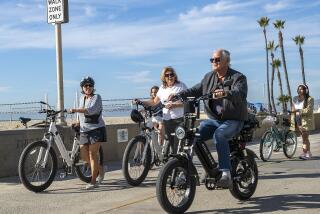Bike Violators’ Choice: Fine or Traffic School
- Share via
Last month, like thousands of other traffic violators, Jose Corona had his day in court. He pleaded guilty and was given a choice: Pay a fine or go to school.
However, Jose’s case is a bit different. He is 13 years old, and he broke the law by riding double on a bicycle. Jose decided to attend bicycle safety school, and he said his choice was the right one.
“I’m gonna quit riding double (on a bicycle) . . . so I won’t get in trouble anymore,” Jose said. “It’s better to follow the rules then get a ticket.”
Jose’s case is one of more than 1,800 bicycle violation cases, ranging from running stop signs to riding against traffic, that are heard each year in the Norwalk Superior Court Juvenile Division, court officials said.
Until recently, Norwalk was the only court in the county to give young offenders the option of paying a fine--usually $10 for the first offense--or attending one of three bicycle safety schools within the court’s domain, said Herbert May, a Norwalk juvenile court referee who originated the program 10 years ago. May said a similar program began recently in Torrance Superior Court.
May said that about 95% of the minors who come through the Norwalk court elect to attend safety school. The results, law enforcement officials say, have been significant.
“We don’t get a lot of repeaters,” said South Gate Police Sgt. Lloyd Carter. “They don’t want to go
through the hassle of going through Juvenile Court (again). I also believe the school has an impact on their behavior by letting them know how dangerous it is to ride” oblivious to the rules of the road, he said.
May said the three schools serving the Norwalk court, operated by the South Gate and Downey police departments and by the Lakewood Sheriff’s Station, offer lectures by police officers and films on bicycle safety. He said that once a youngster attends a school, that person can no longer use the traditional defense that he or she was ignorant of the law.
The service area encompassed by the three schools includes all of the court’s domain, including 20 Southeast cities: Artesia, Bell, Bellflower, Bell Gardens, Cerritos, Cudahy, Commerce, Downey, Hawaiian Gardens, Huntington Park, Lakewood, La Mirada, Maywood, Montebello, Norwalk, Pico Rivera, Santa Fe Springs, South Gate, Vernon and Whittier.
The South Gate class, which police say is attended by an average of 50 youngsters each month, is held in a city park on the first Saturday of the month. The program uses the department’s reserve officers as instructors.
About 20 young people attended the first of two sessions held at the park this month. One of the young people attending, Mario Monge, said before the class that he knew it was against the law to ride double on a bicycle, but he did it anyway.
“My parents asked me if I knew that I wasn’t supposed to be doing that and I told them ‘yea,’ ” he said. “Then they asked me why I did it and I didn’t have a reason.”
When South Gate officer Hugo Rodriguez walked to the front of the room, silence fell.
“We all know why we’re here,” Rodriguez said. “We’re going to take a look at a film, so don’t fall asleep.”
As the film rolled, the students were told a comical story about “Rooty Toot Jefferson” and his overweight friend “Slim Jim McGutney,” who are members of a band of 10 monkeys that, because of their lack of concern for traffic laws, was involved in an array of traffic accidents that ranged from being struck by a steamroller to riding into a manhole.
The second film was of a more serious nature. The students viewed actors who encountered real-life traffic situations. The film emphasized that bicyclists should watch traffic with the same intensity as motorists.
After the film, Rodriguez asked a few questions and read from three police traffic accident reports to show students just how serious it can be to make a mistake on a bicycle.
May said that errant bicyclists who skip class don’t get a second chance. They have to come up with the violation fee originally assessed by the court.
More to Read
Sign up for Essential California
The most important California stories and recommendations in your inbox every morning.
You may occasionally receive promotional content from the Los Angeles Times.













